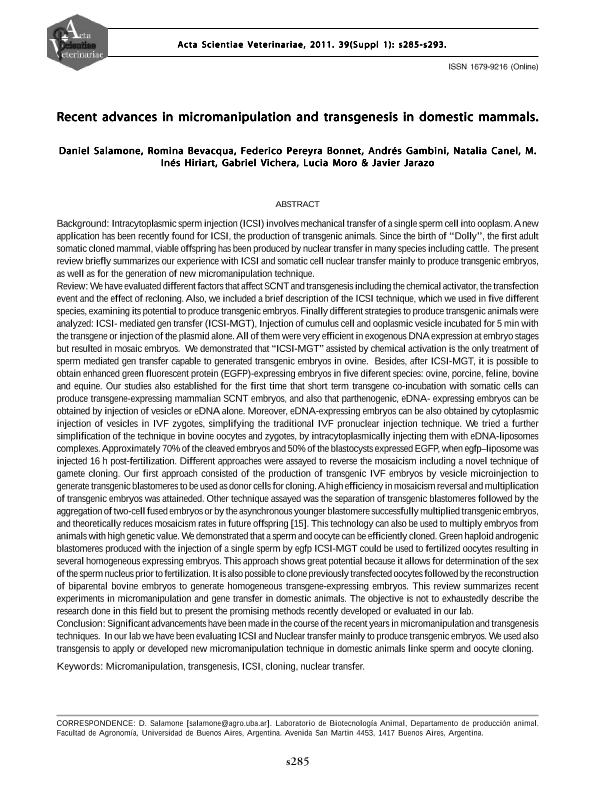Mostrar el registro sencillo del ítem
dc.contributor.author
Salamone, Daniel Felipe

dc.contributor.author
Bevacqua, Romina Jimena

dc.contributor.author
Pereyra Bonnet, Federico Alberto

dc.contributor.author
Gambini, Andres

dc.contributor.author
Canel, Natalia Gabriela

dc.contributor.author
Hiriart, María Inés

dc.contributor.author
Vichera, Gabriel Damian

dc.contributor.author
Moro, Lucía Natalia

dc.contributor.author
Jarazo, Javier
dc.date.available
2017-04-25T19:36:57Z
dc.date.issued
2011-12
dc.identifier.citation
Salamone, Daniel Felipe; Bevacqua, Romina Jimena; Pereyra Bonnet, Federico Alberto; Gambini, Andres; Canel, Natalia Gabriela; et al.; Recent advances in micromanipulation and transgenesis in domestic mammals; Univ Fed Rio Grande Do Sul; Acta Scientiae Veterinariae; 39; suppl. 1; 12-2011; 285-293
dc.identifier.issn
1678-0345
dc.identifier.uri
http://hdl.handle.net/11336/15727
dc.description.abstract
Background: Intracytoplasmic sperm injection (ICSI) involves mechanical transfer of a single sperm cell into ooplasm. A new application has been recently found for ICSI, the production of transgenic animals. Since the birth of ‘‘Dolly’’, the first adult somatic cloned mammal, viable offspring has been produced by nuclear transfer in many species including cattle. The present review briefly summarizes our experience with ICSI and somatic cell nuclear transfer mainly to produce transgenic embryos, as well as for the generation of new micromanipulation technique. Review: We have evaluated different factors that affect SCNT and transgenesis including the chemical activator, the transfection event and the effect of recloning. Also, we included a brief description of the ICSI technique, which we used in five different species, examining its potential to produce transgenic embryos. Finally different strategies to produce transgenic animals were analyzed: ICSI- mediated gen transfer (ICSI-MGT), Injection of cumulus cell and ooplasmic vesicle incubated for 5 min with the transgene or injection of the plasmid alone. All of them were very efficient in exogenous DNA expression at embryo stages but resulted in mosaic embryos. We demonstrated that “ICSI-MGT” assisted by chemical activation is the only treatment of sperm mediated gen transfer capable to generated transgenic embryos in ovine. Besides, after ICSI-MGT, it is possible to obtain enhanced green fluorescent protein (EGFP)-expressing embryos in five diferent species: ovine, porcine, feline, bovine and equine. Our studies also established for the first time that short term transgene co-incubation with somatic cells can produce transgene-expressing mammalian SCNT embryos, and also that parthenogenic, eDNA- expressing embryos can be obtained by injection of vesicles or eDNA alone. Moreover, eDNA-expressing embryos can be also obtained by cytoplasmic injection of vesicles in IVF zygotes, simplifying the traditional IVF pronuclear injection technique. We tried a further simplification of the technique in bovine oocytes and zygotes, by intracytoplasmically injecting them with eDNA-liposomes complexes. Approximately 70% of the cleaved embryos and 50% of the blastocysts expressed EGFP, when egfp–liposome was injected 16 h post-fertilization. Different approaches were assayed to reverse the mosaicism including a novel technique of gamete cloning. Our first approach consisted of the production of transgenic IVF embryos by vesicle microinjection to generate transgenic blastomeres to be used as donor cells for cloning. A high efficiency in mosaicism reversal and multiplication of transgenic embryos was attaineded. Other technique assayed was the separation of transgenic blastomeres followed by the aggregation of two-cell fused embryos or by the asynchronous younger blastomere successfully multiplied transgenic embryos, and theoretically reduces mosaicism rates in future offspring [15]. This technology can also be used to multiply embryos from animals with high genetic value. We demonstrated that a sperm and oocyte can be efficiently cloned. Green haploid androgenic blastomeres produced with the injection of a single sperm by egfp ICSI-MGT could be used to fertilized oocytes resulting in several homogeneous expressing embryos. This approach shows great potential because it allows for determination of the sex of the sperm nucleus prior to fertilization. It is also possible to clone previously transfected oocytes followed by the reconstruction of biparental bovine embryos to generate homogeneous transgene-expressing embryos. This review summarizes recent experiments in micromanipulation and gene transfer in domestic animals. The objective is not to exhaustedly describe the research done in this field but to present the promising methods recently developed or evaluated in our lab. Conclusion: Significant advancements have been made in the course of the recent years in micromanipulation and transgenesis techniques. In our lab we have been evaluating ICSI and Nuclear transfer mainly to produce transgenic embryos. We used also transgensis to apply or developed new micromanipulation technique in domestic animals linke sperm and oocyte cloning.
dc.format
application/pdf
dc.language.iso
eng
dc.publisher
Univ Fed Rio Grande Do Sul

dc.rights
info:eu-repo/semantics/openAccess
dc.rights.uri
https://creativecommons.org/licenses/by-nc-sa/2.5/ar/
dc.subject
Micromanipulation
dc.subject
Transgenesis
dc.subject
Icsi
dc.subject
Cloning
dc.subject.classification
Tecnología GM, clonación de ganado, selección asistida, diagnósticos, tecnología de producción de biomasa, etc.

dc.subject.classification
Biotecnología Agropecuaria

dc.subject.classification
CIENCIAS AGRÍCOLAS

dc.title
Recent advances in micromanipulation and transgenesis in domestic mammals
dc.type
info:eu-repo/semantics/article
dc.type
info:ar-repo/semantics/artículo
dc.type
info:eu-repo/semantics/publishedVersion
dc.date.updated
2017-04-24T20:42:08Z
dc.identifier.eissn
1679-9216
dc.journal.volume
39
dc.journal.number
suppl. 1
dc.journal.pagination
285-293
dc.journal.pais
Brasil

dc.description.fil
Fil: Salamone, Daniel Felipe. Consejo Nacional de Investigaciones Científicas y Técnicas. Oficina de Coordinación Administrativa Pque. Centenario. Unidad Ejecutora de Investigaciones En Producción Animal. Universidad de Buenos Aires. Facultad de Ciencias Veterinarias. Unidad Ejecutora de Investigaciones En Producción Animal; Argentina
dc.description.fil
Fil: Bevacqua, Romina Jimena. Consejo Nacional de Investigaciones Científicas y Técnicas. Oficina de Coordinación Administrativa Pque. Centenario. Unidad Ejecutora de Investigaciones En Producción Animal. Universidad de Buenos Aires. Facultad de Ciencias Veterinarias. Unidad Ejecutora de Investigaciones En Producción Animal; Argentina. Consejo Nacional de Investigaciones Científicas y Técnicas. Oficina de Coordinación Administrativa Parque Centenario; Argentina
dc.description.fil
Fil: Pereyra Bonnet, Federico Alberto. Hospital Italiano; Argentina
dc.description.fil
Fil: Gambini, Andres. Universidad de Buenos Aires. Facultad de Agronomia. Departamento de Producción Animal. Cátedra de Fisiología Animal; Argentina
dc.description.fil
Fil: Canel, Natalia Gabriela. Universidad de Buenos Aires. Facultad de Agronomia. Departamento de Producción Animal. Cátedra de Fisiología Animal; Argentina
dc.description.fil
Fil: Hiriart, María Inés. Universidad de Buenos Aires. Facultad de Agronomia. Departamento de Producción Animal. Cátedra de Fisiología Animal; Argentina
dc.description.fil
Fil: Vichera, Gabriel Damian. Universidad Nacional de San Martín; Argentina
dc.description.fil
Fil: Moro, Lucía Natalia. Fundación para la Lucha contra las Enfermedades Neurológicas de la Infancia; Argentina
dc.description.fil
Fil: Jarazo, Javier.
dc.journal.title
Acta Scientiae Veterinariae

dc.relation.alternativeid
info:eu-repo/semantics/altIdentifier/url/http://www.ufrgs.br/actavet/39-suple-1/34%20Supl_s285-s293.pdf
Archivos asociados
